Services & F.A.Q.
(For frequently asked questions – Scroll down below GRAND-Types & Sizes)
Services & F.A.Q.
(For frequently asked questions – Scroll down below GRAND-Types & Sizes)
PIANO SERVICES
Services costs at hourly rates of $120.
STICKING KEYS : This is the catch all expression for anything not working correctly, slow hammers, key will not go down, note continues playing even when the key is released or maybe it does “stick” and stays down when you press the key.
SLUGGISH KEY: Piano keys return back up slowly, if it becomes sluggish, the note will not repeat. That means you can play it once, but the second time it may not make a sound. Because this part is not easy to access, typically the action must be removed from the piano. Removing the action is easy on an Vertical piano and only slightly more difficult on a grand piano. There can also be objects like pens, pencils etc. dropped in the piano, which could be easy to adjust. REGULATION: While tuning corrects the pitch of your piano, it is only one component of a complete maintenance program. Regulation attends to the touch and uniform responsiveness of the action. All vital to making each performance pleasurable. Regulation is the adjustment of the mechanical aspects of the pianos to compensate for the effects of wear, the compacting and settling of cloth, felt and buckskin, as well as dimensional changes in the wood pars due to changes in humidity. BROKEN STRINGS, KEY TOP REPAIRS, VOICING and CLEANING THE INSIDE of YOUR PIANO, call for more information.
Pianos need Tunings
Taking care of your piano means not just dusting it but most importantly “Tuning It”.
By tuning your piano you are insuring that it will last for many years, it will hold its value, “protecting your investment” and it will be a lot more fun to play!
There are a variety
of factors that contribute to tuning instability:
Atmospheric changes:
Dependent on the location in your home.
Placed near doors or poorly insulated windows.
Placed over an air register or sits near a beam of direct sunlight.
The soundboard and bridges in your piano are mostly made of wood causing fluctuations in humidity. When there is a lot of moisture in the air the soundboard swells and the bridges push up on the strings, it increases their tension and raises the pitch. With lower moisture levels, the wood contracts and the string tension loosens, making your piano fall in pitch.
Some pianos are harder to tune than others, and with neglect and age may not be tunable.
VOICING THE HAMMERS
Every piano has its own distinct sound or “voice”.
In many ways, that’s how it was built and that is
its personality.
But over time, the more a piano is played, the
more the hammer felt that strikes the strings
wears down and compacts.
This hardening can cause the tone to become
too harsh or bright, and it’s difficult to produce a
wide or even range of expression or tone, no
matter how much you try to play using dynamics.
In other situations, the piano may seem too dull
or lifeless for your taste with little natural sustain.
Either way, the hammers can be treated in
various ways: by aligning, shaping, carefully
needling or hardening the hammers, in order to
come closer to the tone you’re looking for.
Keep in mind, however, that a piano has to be
finely tuned, the strings properly seated on their
bearing points, and regulated before the
hammers can be voiced.
Evaluation of your Piano

Evaluation cost $185.
Evaluations for your piano or for insurance needs. The Evaluation reflects my background of over 50 years in the piano business, which includes buying, Evaluation and selling pianos in the San Francisco Bay Area. I will do an on site inspection of the piano to ascertain a general sense of the current market value. I will complete an evaluation in one service call.
VERTICAL PIANOS-Types & Sizes
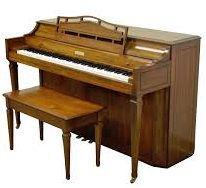
Spinet Piano
Height 36" to 39"
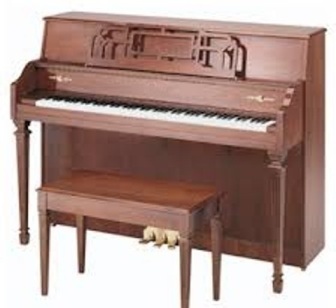
Console Piano
Height 40" to 44"
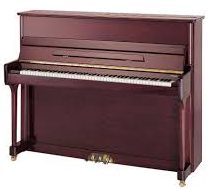
Studio Piano
Height 45" to 49"

Upright Piano
Height 50" to 60"
GRANDS – Types & Sizes
There are a number of different descriptions of grand pianos
Piano Companies have different general terms for there piano sizes
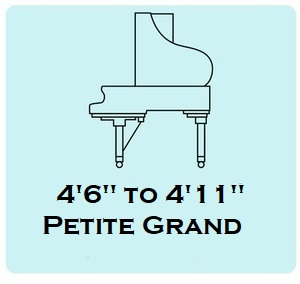


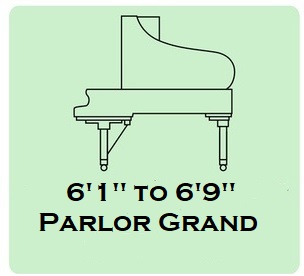


F.A.Q.
(Frequently Asked Questions)
To view articles click on the buttons below
To view information click on the text below
There are several factors: most dramatic is humidity and temperature changes that affect the soundboard, causing it to expand and contract, altering the strings. Over time a piano’s strings will continue to stretch. Moving the piano can “bump” strings slightly out of tune. Finally, frequent playing, especially aggressive playing can “settle” the string’s tension between bridge points if they haven’t been properly set.
There are several factors: most dramatic is humidity and temperature changes that affect the soundboard, causing it to expand and contract, altering the strings. Over time a piano’s strings will continue to stretch. Moving the piano can “bump” strings slightly out of tune. Finally, frequent playing, especially aggressive playing can “settle” the string’s tension between bridge points if they haven’t been properly set.
The strings of a new piano will continue to stretch and settle during the piano’s first year or so, requiring several tunings the first two years to keep it in tune and up to pitch. Thereafter, a piano should be tuned at least yearly Every 6 months in an environment with more extreme humidity or temperature fluctuation. Heavily used pianos will also increase the need for tunings. Strings will continue to stretch and alter even if the piano is not used, so regular piano tunings are still a must to keep a piano in optimum shape.
Cost for a Piano Tuning is $215. A pitch raise, if necessary, is an additional $50. (If a piano hasn’t been tuned for a few years it will usually have dropped in pitch. In this case it will need a pitch raise before it can be effectively tuned, on the same day.) Other repairs (hammers, keys, pedals, etc.) are billed at $120. per hour. Major repairs, regulation, etc. will require a bid after seeing the piano.
Seems like a no-brainer since strings out of tune can sound real sour. But in addition, a piano that is not tuned regularly and kept up to pitch will never give you the full tone and richness of sound for which it was designed. A piano is almost always slowly dropping in pitch which, if not corrected over time, can require even more maintenance and pitch raising.
Yes! Many people are unaware of this fact. With eighty-eight different keys the feel and sound of each note may become unbalanced and the touch may lose its maximum efficiency and sensitivity. Often, a pianist will complain of sluggish feeling keys, lack of response, a heavy touch, bobbling or double striking keys, and uneven sounding notes. This will happen to every piano over time without proper ongoing maintenance.
The exterior of any piano, the keys, and inside the cabinets of grands require regular cleaning that you can do. Clean your piano’s finishes and keys with a soft damp cloth (preferably a microfiber cloth). You can use a solution of 2 tablespoons white vinegar to 1 gallon of warm water, or a mild dish soap on particularly soiled areas. The inside area of a grand piano (above the strings) should be frequently vacuumed.
As a piano tuner I can clean inside and around the action and all of its parts, under and behind the strings, and many other areas that are not as easily accessed. Very old pianos may still have real ivory key tops (no longer used on newer pianos) which can stain or discolor and may require special treatment by a technician. Modern keys are made of a hard plastic that can be cleaned with a non-abrasive window or kitchen cleaner (such as Windex or Formula 409). For high gloss piano finishes I recommend a high gloss piano polish available “Kleenmaster-Brillianize” can be purchased at a TAP PLASTICS store near by
Homes today are well insulated so the old taboo of pianos against an outside wall is no longer a concern. However, pianos should not be exposed to extreme temperature changes such as heat or air conditioning vents or long periods of direct sunlight. In areas with high or extreme changes in humidity a specially designed climate control system can be installed in your piano. Feel free to visit with me about this. An ideal range of temperature is between 65 to 72 degrees, and a constant humidity level of close to 42% percent is optimum.
Whether buying a new piano from a dealer or a used piano off of the want-ads, a newer piano can be an exciting and wonderful addition to your home or studio. Piano dealers are trained and reputable and are almost always a safe bet for purchasing a piano. You may expect to pay slightly more than you would through the want-ads, but you should also be able to expect their professional services and care for your piano. Buying a piano from the want-ads can also find a great instrument, but there are things to beware of:
- Avoid pianos that are “give- a-ways” (fixer uppers, $50 or free if you pick up, etc.) They almost always are in need of several hundred if not thousands of dollars of repairs. Yes, pianos can outlive their playability and sometimes just need to be “retired”. I have visited many a home of a client that found a cheap piano on classifieds ads for a very low price and I’ve had to deliver the news that it needed over a thousand dollars of repairs and even then won’t be worth the money they put into it. Far better to spend more on a piano that is still in good condition.
- Be very cautious of the tall, older upright pianos (sometimes called an upright grand). Many people are enamored with the charm of the beautiful cabinet work or the vintage appeal of the piano, but ALMOST ALWAYS these pianos are in need of maintenance or major repairs and part replacements resulting in hundreds of dollars. Often the strings will be rusty and the bass strings (with copper or steel winding) will be so full of gunk and residue that their resulting sound is as much a “thud” as a tone!
- Be cautious of what is referred to as a “spinet” piano. Spinet pianos became popular after WWII as they saved space with their compact design. A spinet piano will be shorter and also “deeper” from the front to back. This is a result of locating the interior action of the piano down inside the keys instead of on top of the keys as you would find in a normal console piano. This design presents many problems, the biggest of which is the shorter strings resulting in less tone, richness, and volume. This also presents tuning and stability problems. Other problems result from spinet pianos being much more difficult to service because of the their design. Also, while there are still some spinets of good quality, many were built on the “cheap” and are fraught with problems such a brittle and breaking glue joints, disintegrating plastic parts, and more.
- Never buy a piano sight unseen, even if you have seen pictures. Just like buying a used car, many problems are not immediately evident without proper inspection. If you are looking at a used piano, some of the things you can check for are straightness and evenness of keys, properly function pedals, and a desirable and consistent touch and sound. Even more important, open the front part of the cabinet (usually done quite easily by lifting the lid and undoing small latches or screws at the top corners of the front piece) and inspect the action and the wires. Things to beware of are: rusty, discolored strings in the mid to upper sections (should shiny silver) and strings in the bass section that are discolored or dusty looking but the dust doesn’t clean off. These wound wired strings should be a bright and shiny metallic copper look. Beware of felt hammers that are un-even, discolored or stained, or have noticeable deep grooves where they strike the strings (anything more than 1/16th of an inch can be a problem) or are loose and wobbly. Extreme amounts of dust and dirt in the cabinet. Any loose wooden fragments on the wooden keys that should be securely glued. Look at the felt “bushings” (the holes in the keys that allow the keys to sit straight. They should be even and usually a bright red felt. As they become worn you will notice the keys are loose as you wiggle them from side to side.

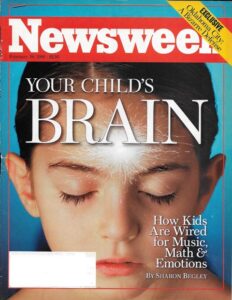 toggle Content n
toggle Content n
Lorem ipsum dolor sit amet, consectetur adipiscing elit. Ut elit tellus, luctus nec ullamcorper mattis, pulvinar dapibus leo.
